At long last, after lots of research, lots of work, some triumphs, and a few setbacks, I’ve finished my first proper medieval garment.
I got it completely ready to wear, except for sewing four buttons on the cuffs, for a historical dinner on Saturday. I wore it for the dinner with cuffs unbuttoned, and then I finished the buttons on Monday.
On Thursday the weather was beautiful (if cold) and the gorgeous Elizabeth of Ills Winter and I spent the late afternoon hanging out at the Sir Truby King gardens, taking pictures and generally having fun.
I only ended up putting 11 buttons on the sleeves, because of buttonhole issues (more about that in a later post), but I could add more later if I wished.
I’m reasonably happy with the finished result. The neckline is a little too scooped, the sleeves a little too long, my buttonholes more than a little rubbish, but as a learning piece, it’s not bad at all! The next one will be much better!
I definitely feel I’ve got the right silhouette for the 1360s-70s – the quite androgynous, flattened chest, the dress beginning to tighten at the waist, but without the real waist emphasis of later decades. In a pinch it will do for anything from 1350s-90s. Not that I have many events to go to where real date-specific period accuracy for this period is called for! Still, I think looking at a very specific, narrow period, and trying to make it fit exactly that really helped me to think about period accuracy vs. modern interpretations of fit an attractiveness.
Side note: can we talk about my seriously impressive hemming job? I got a friend to pin the floor length at all the seam lines, but too many pins fell out before I was able to get to hemming it, so I ended up doing it almost entirely by myself, using a mirror propped on the floor, and carefully cutting away tiny bits where the fabric brushed the ground, until it was even all around. It almost makes up for the buttonholes!
The circlet, belt and veil are just quick costume jobs, but they were quite fun to do and are very effective. I’m almost done with a proper veil in very fine linen, but didn’t quite get the rolled hems done in time for the photoshoot.
Taking photos at the Sir Truby King gardens, or anywhere in NZ for that matter, pushed the medieval boundaries a bit. Everywhere I look there were trees that did not exist in Medieval Europe! Like that cabbage tree in the photo above.
Or this ringa ringa lily:
Or this camellia:
We finally settled on a pine wood as reasonably plausible. For those ones I unpinned my braids and took off the veil, for a more romantic Pre-Raphealite take on the Middle Ages.
And just to be totally a-historical, the final photo works best if you either make Jaws noises or sing ‘Little Bunny Frou Frou, creeping through the forest…’ in your spookiest voice to it.

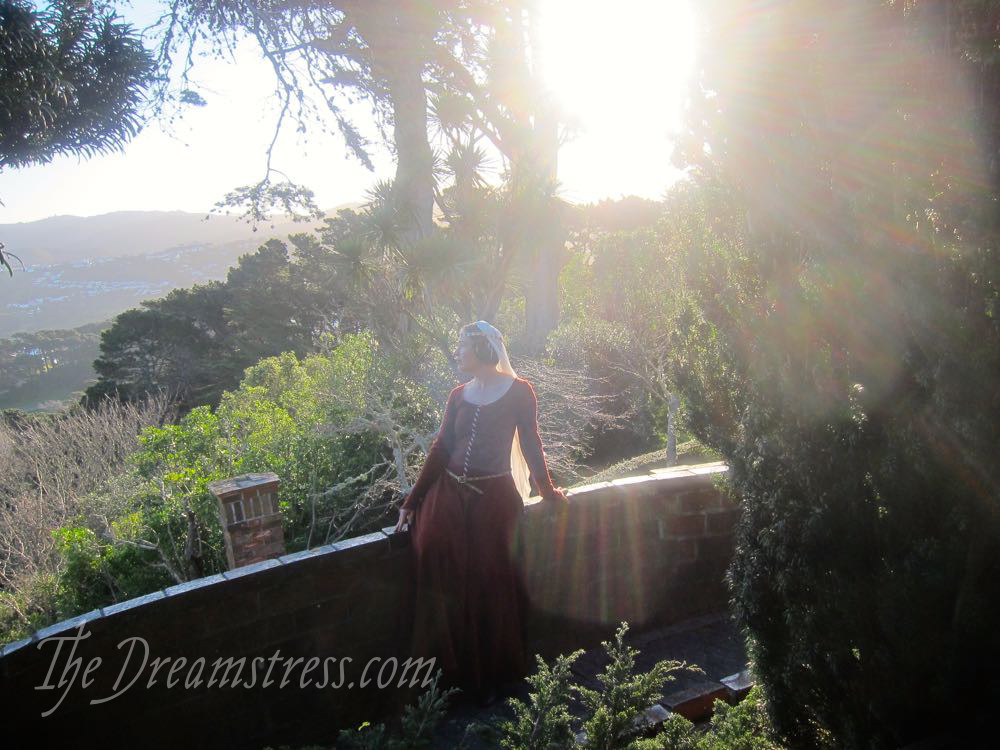
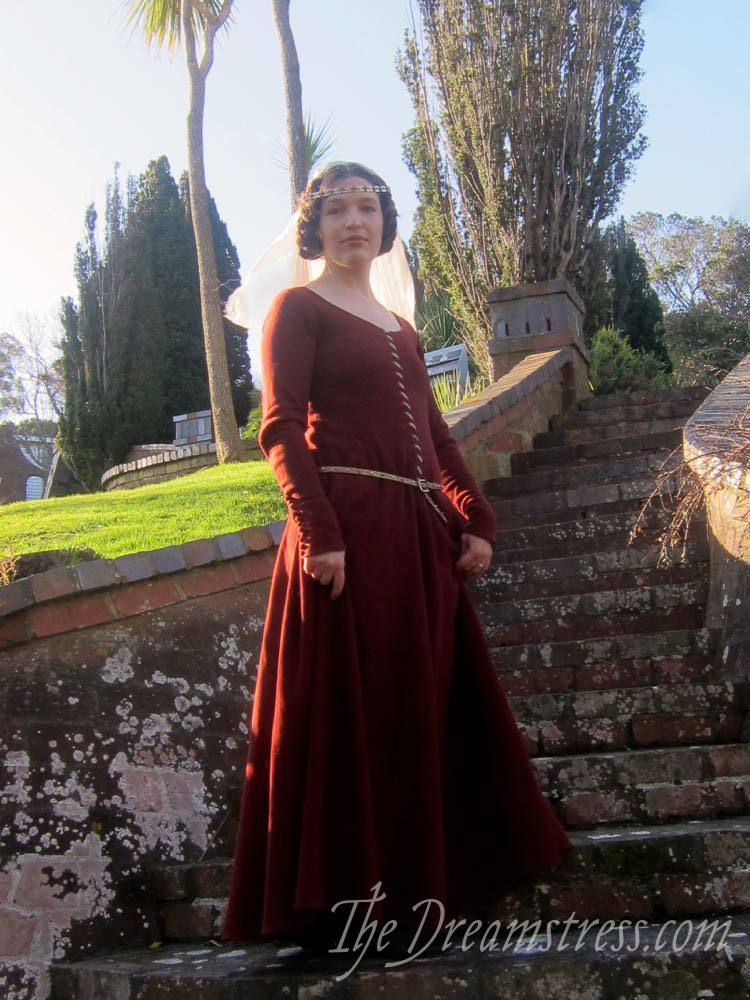
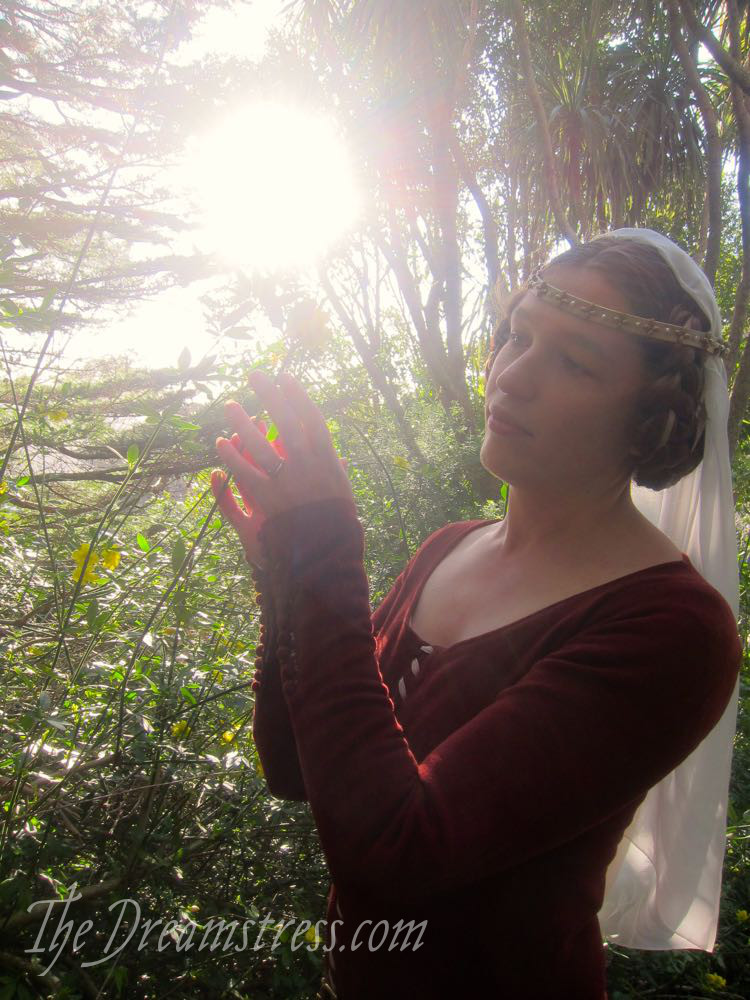

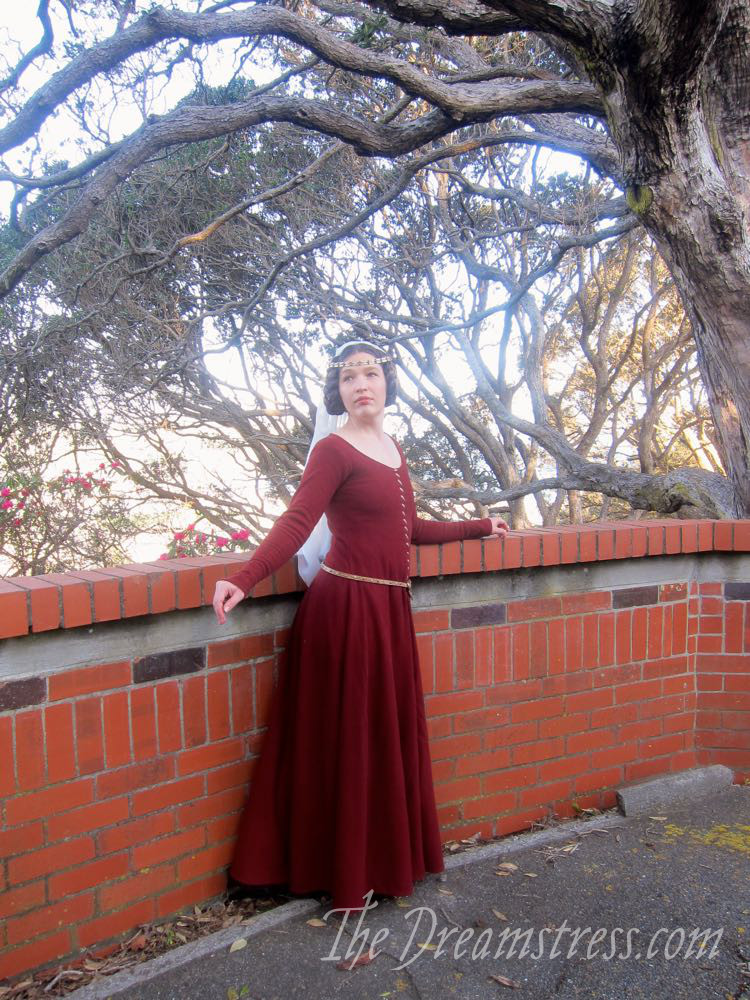
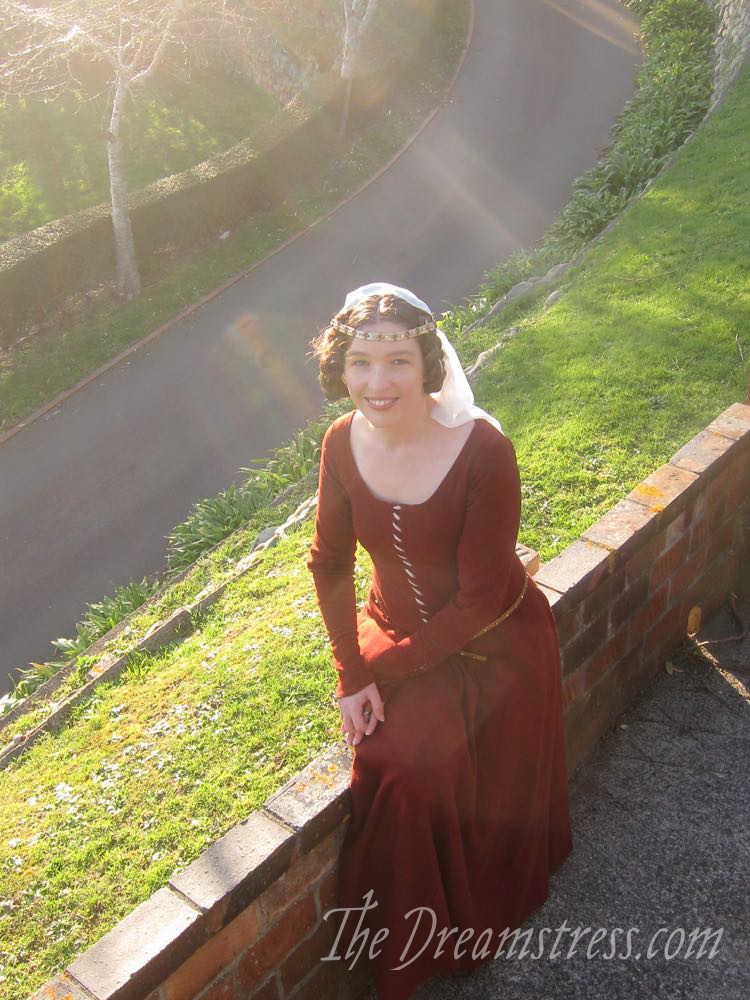
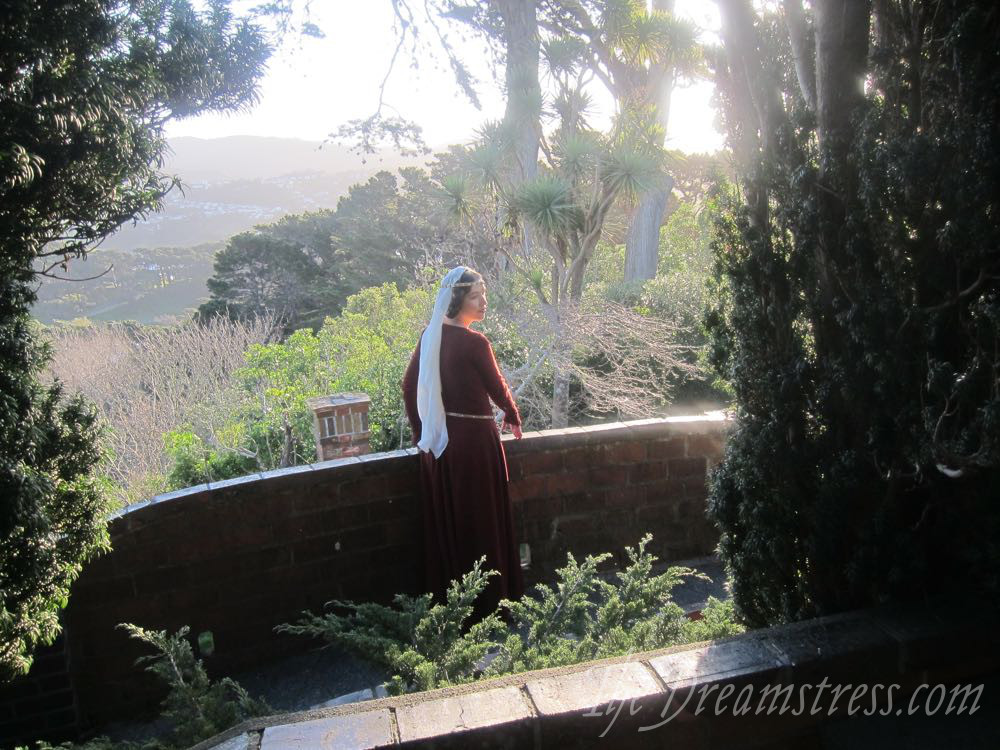
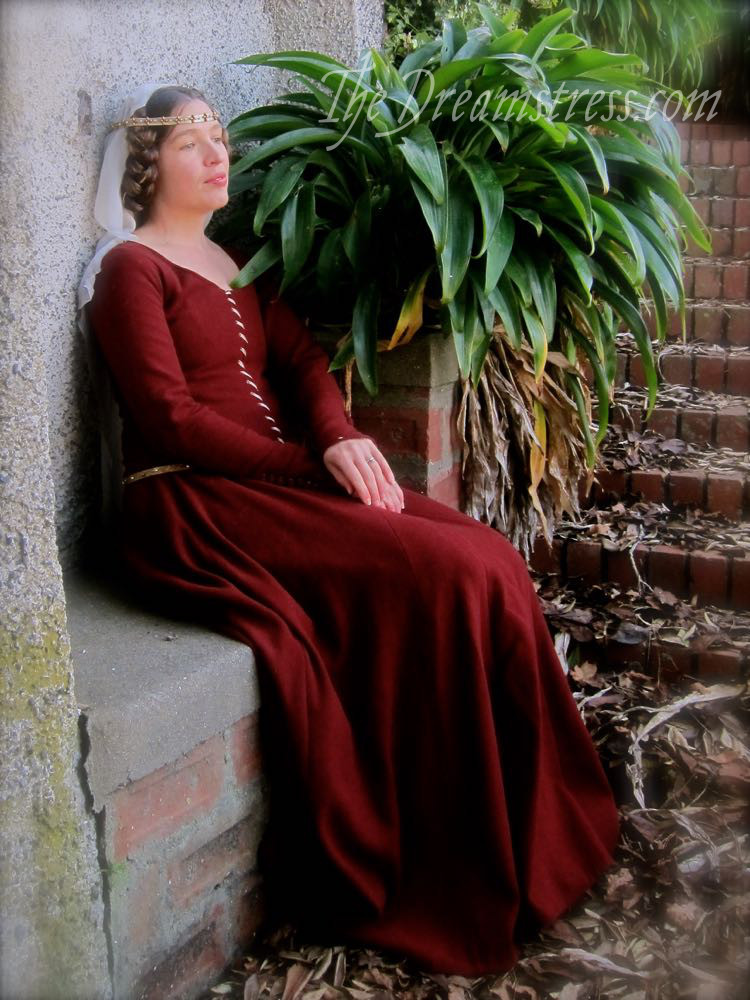
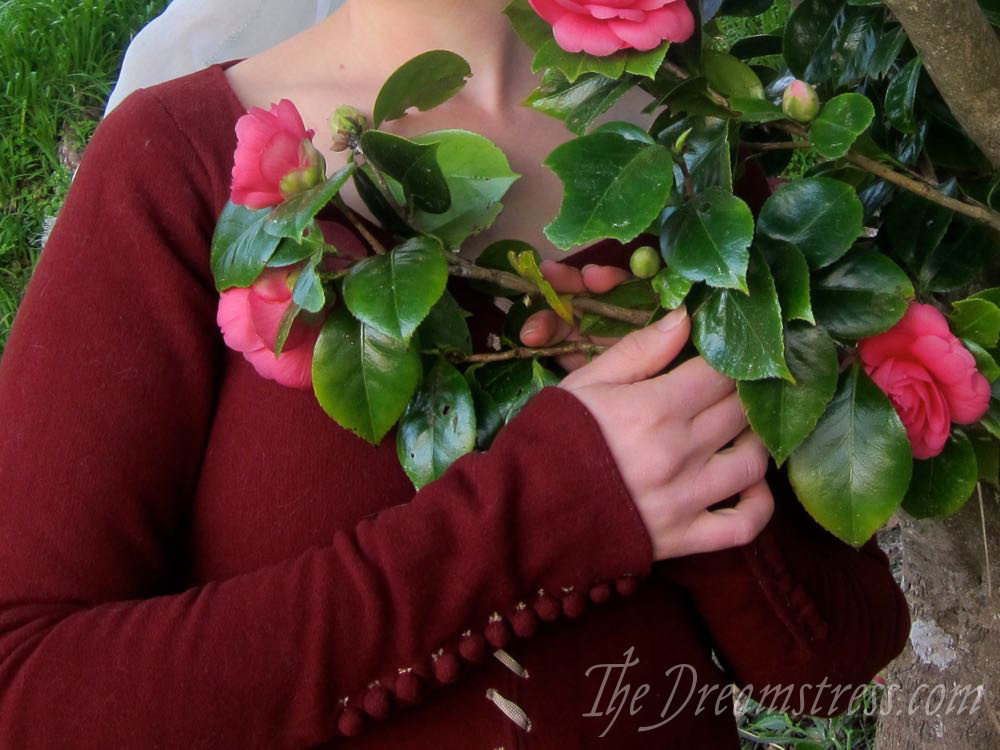

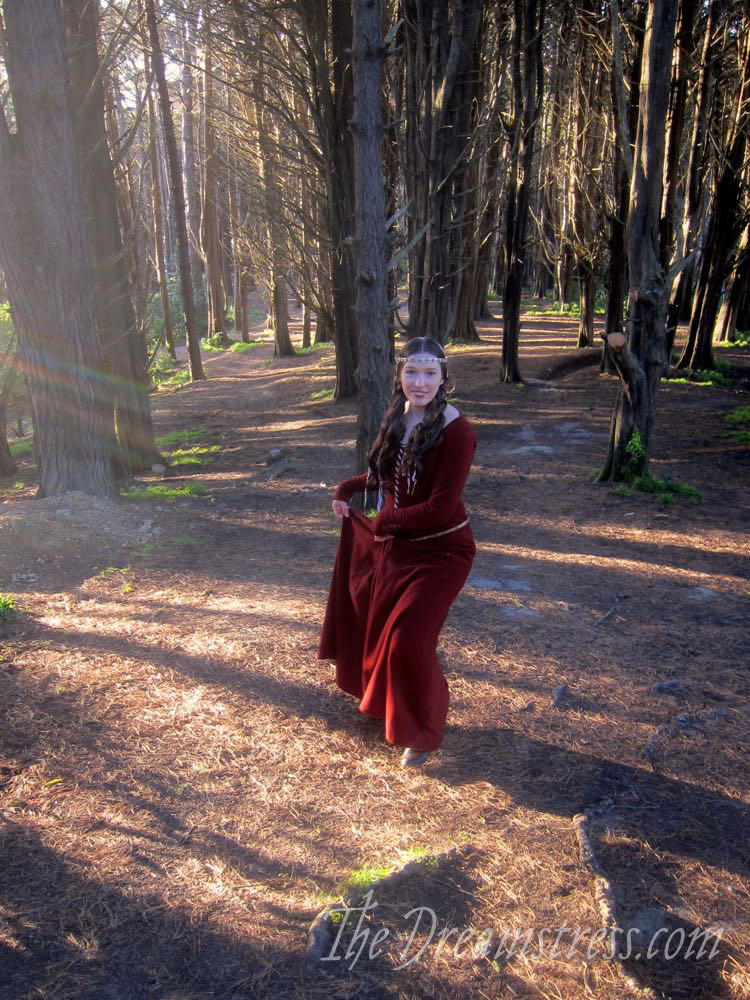
Gorgeous! And I quite like the medieval/NZ mix; it sparks off all sorts of interesting ideas in my mind. Although now I have “Little Bunny Frou Frou” running through my head, and did you find any mice to bomp?
Thank you!
No mice, but later in the spring that area is a good place to spot baby quail (thread spool sized bundles of adorableness – be still my heart!) 😉
You have done a marvellous job. Amazing hemming. The buttons certainly look the part. May I ask if you used your sewing machine or did you do it all by hand? – as per really medieval. Love that colour on you, it’s quite regal.
Well done.
Thank you!
I machine sewed the long seams, and hand sewed everything else (facings, buttons, buttonholes, hems, lacing holes etc). I have to limit the amount of hand-sewing I do in winter because I get terrible chillblains, and hand sewing is slow and painful 🙁 My next one will be entirely hand sewn though!
I really love this, and the way it looks on you. I do think it is important to pick a period that suits you and your figure type. I could never do 1920s, even when young. Too much bust, and I looked like a rain barrel. Given a good corset (if I’d known how to make them at the time) I could have done the Naughty Nineties, and been a star!
The hem is very impressive – I know how difficult solo hemming can be.
Thank you! I am VERY pleased with this, and how it looks and how I feel in it! I’m so grateful to all the people who gave me advice and moral support throughout my journey!
I’ve seen photos of you when you were young, and I’m pretty sure the periods when you wouldn’t have been the belle of the ball were by far the exception rather than the rule! 😀
Beautiful! I’m far from an expert on this era, but it looks great to my eyes: love the color and silhouette, well done!
Thank you!
I’m not an expert either, but I do feel I’ve learned a lot, and I’m really pleased with the result. 🙂
oh that’s lovely!
Thank you! <3
‘Twas brillig, and the slithy toves
Did gyre and gimble in the wabe;
All mimsy were the borogoves,
And the mome raths outgrabe.
Bella!
Lol! Thank you!
Wow! That is so gorgeous!
Awww, thank you!
You look amazing in this! It is so flattering and romantic on you! You look totally lovely. And the setting is beautiful. I love it!
Thank you very much! I’m touched and flattered!
It came out very well, and the color suits you splendidly. Enjoy it!
Thank you so much! That’s particularly flattering coming from you!
I love how this turned out! The style really suits you, and the photos are lovely
It looks lovely but eerie since I can’t get over that image of the plague ( the so called ” black death” epidemic) killing 1/3 of the european population around the year 1350.
That would be Felicity’s contribution as the vector for the black plague
was fleas on rats.
Not infurring that Felicity has cooties….but she knows her hiss-story.
Now don’t be blaming Felicity’s furbearers! They either comes off as the heroines of the story, or as totally innocent.
If you accept the idea that the plague was carried on fleas on rats, then cats are actually credited with preventing its spread, and one of the things that allowed it to re-spread was people going hysterical and wiping out the cat populations – the plague did seem to be worse in places where cats were wiped out (thought this may be correlation rather than causation – areas where there was widespread hysteria and persecution of certain groups also tended to have less organised responses to the disease, and less ability to cope with secondary outbreaks, and thus less ability to prevent its spread).
However, modern research and a better understanding of diseases and how they spread is making the flea carrier story less and less likely, as the plague spread far too quickly and widely for something that was blood-borne and transmitted through flea bites. Current research suggests it was much more likely to be transmitted in the same way that other swift epidemics like the Spanish flu of 1918, or the recent Ebola epidemic were: through body fluids.
Felicity may know her his-tory, but my personal history has given me a slightly creepy fascination with epidemics and nasty diseases 😉
I hear what you are saying there! My professional background was in medical pathology and the nastiest viruses are
the most beautiful under the microscrope. It could be speculated that the plague was worse in the regions
where superstitious folks concocted stories about cats being “familiars”. Research has shown that diseases of
the Middle Ages followed the trade routes – Silk Road and others.
I see I shall have to quote my sauce: AbleSeacat Simon of the HMS Amethyst, who sadly fell fowl of an
opportunistic colonization of microbes that hadn’t figured out how to live in symbiosis with their host.
It is strongly believed that bacteria carried by body lice killed more chaps in 14-18 through disease
than bullets ever did. Then there was the Spanish Influenza which was no “lady” at all.
There are positives in having a keen interest in this subject matter. Spirited discussion at the
buffet/smorgasbord table inspires the squeamish to excuse themselves resulting in the happy situation of more
food for moi!
And if that ain’t cat smarts, I’ll go She!
That is true – it’s just a few decades later. There are all sort of other periods in history where people in any given locale would have watched huge amounts of their local population get wiped out. There was a huge famine in England in 1317-18, and plague reoccured regularly right up until the 19th century. Plus lots of other fevers and diseases. The plague may have been awful, but it did contribute to the creation of modern England, and thus most of modern Western civilisation, in lots of positive ways. Serfdom ended, education rose, wages rose, standards of livings rose in a way that would be unmatched in the rest of the Western world until the 19th century. For those that survived, the 1360s onward would actually have been a wonderful time to live in.
When you think of the ’20s is that image hugely overshadowed by the 1918 flu?
I guess the amazing thing about humanity is how resilient it is. How quickly we pick up, dust ourselves off, and go on living. And I actually think that’s a rather beautiful image!
It’s so lovely! Well done. 🙂 Also on the ear braids.
Thank you! I’m really pleased about the ear braids. They took a bit of figuring out now that I’ve cut my hair to shoulder level. I’ve used two sets of extensions, but the real trick was weaving ribbons into the braids, so I had something to hold the loose ends in, and to tie over the top of my head. I should do a little tutorial on how I did it…
So pretty!!!! 🙂 Your work is always breath-taking, and the photo shoots look like such fun! I always enjoy them vicariously!
Awww, thank you! That’s incredibly sweet of you! I enjoy living vicariously through so many people’s blogs, so I’m really glad that I’m able to pass it on a bit too!
It looks really good, love the hemming and I totally get how hard that is as I normally have to hem by myself too. I think it’s quite a flattering look too.
Thank you! Hemming by yourself is quite a mission. You have my full sympathy! I’m really impressed with how comfortable and flattering it is too!
I am a Mediaevalist (language, mainly) who loves costuming but finds myself doing mainly 18th century – what a joy to see such a lovely mediaeval gown! The lines are exquisite and I think you’ve done the sleeve length perfectly. You look beautiful as both the 14th century and the pre-Raphaelite lady!
Well done on the hem. It is a mission to do them solo, and you’ve done a great job. I’m very impressed with this dress. It’s beautiful and elegant, and I think it really captures the look of the period. With the veil and the braids it’s just perfect.
Amazing work!
I totally agree with the comment above about mixing Medieval and NZ–very Tolkien feel! 🙂